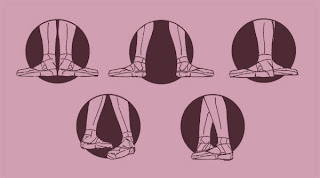Each and every pointe shoe is hand crafted by the various cobblers. The video above shows the process it takes to make the many shoes needed by a ballerina en pointe. When buying a shoe there is usually the first initial of the maker, for example there might be a "maker B.". There are many ways to break in a point shoe so that it is fit to dance in. These include sewing, gluing, bending, cutting...etc. For company performances, shoes can be custom made for the lead dancers.
The Dance Fanatic
Thursday, September 6, 2012
Tuesday, September 4, 2012
Female Ballet Apparel
There are many different options for ballet apparel and these vary depending on the school or studio. However the general idea of the clothing stays the same. All female ballet dancers attending class must wear a leotard which is a skin tight one-piece garment that covers the torso leaving the arms and legs free. The colors of these are usually blue, black, pink, or white. Tights are most commonly pink because it gives a more natural look and does not hide the leg muscles as much as black. In some studios, dancers are permitted to wear black tights, however the most popular color is a light pink. In some locations, dancers can wear small transparent skirts over their leotard during class. Ballet shoes or slippers are usually pink or white and made of leather or canvas. Other items can be worn, such as leg warmers during winter to keep the joints warm and ready to move.
Thursday, August 30, 2012
Basic Positions
There are five basic positions in classical ballet. These are the foundations of the dance and are important to be learned correctly. The first position is one of the easier and simpler ones. All positions are shown in the diagram above and go from left to right, top to bottom. Second position is almost the same as first, however the legs stand farther apart. Third is similar to fifth and the front foot is not fully in front of the back. In fourth position the feet are separated, one in front of the other, like an open fifth. The ideal fifth position is when the feet are turned out and parallel to each other.
When turned out it is important to rotate from the hips rather than the knees or ankles so as to avoid future injury. Any seemingly small bad habits in the particular form of dance can become real problems if one is pursuing a career in the art.
When turned out it is important to rotate from the hips rather than the knees or ankles so as to avoid future injury. Any seemingly small bad habits in the particular form of dance can become real problems if one is pursuing a career in the art.
Tuesday, August 28, 2012
Intro to Ballet
Ballet is a form of dance that has been around for hundreds of years and even today it is taught around the world. It was originally from the Italian Renaissance in the 1500's. It then moved to France and Russia and has been a great influence on countries around the world. The ballet vocabulary is made up of French words that can be translated to explain the movement. For example, the word "fondue" means "to melt". Ballet is usually accompanied by classical music, usually non-lyrical, however there are exceptions. Ballet performances tell stories through mime and music and do not use words portray events. Today there are ballet schools around the world that teach ballet. Female ballet students are taught pointe work and all students are taught the necessary posture, alignment, and balance. There are many other forms of dance, however, ballet can be found in most of them.
Subscribe to:
Posts (Atom)


